 |
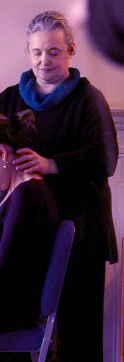 |
Learning the Alexander Technique: FAQs
What happens in an Alexander Technique lesson?
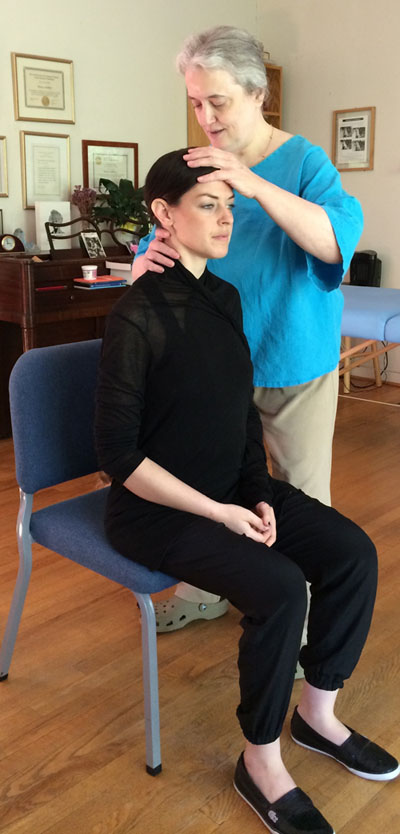 |
Alexander Technique lessons focus on the individual student learning and applying the principles of the Technique in ways that are most beneficial for him/her. This consists primarily of kinesthetic or neuromuscular learning, which is provided by the teacher's gentle hands-on guidance of the student through fundamental movement patterns. Frequent repetition of this guidance during lessons provides the student with the opportunity to move more naturally and easily—without the interference of long-held habits of inefficient coordination and excess tension. The student's system as a whole learns from these new experiences, which provides for in-depth improvements in his or her movement, postural, and breathing habits. Verbal instruction in the principles of the Alexander Technique accompanies the direct neuromuscular re-learning, teaching the student to apply his/her own thinking to participate actively in the learning process. Through practicing the principles of the Alexander Technique, the student learns to change his/her habits, providing for healthier responses to stress, and more natural, comfortable, and efficient movement, breathing, and posture.
What are the benefits?
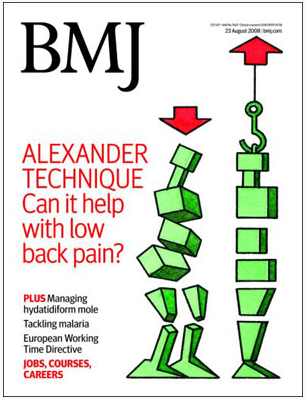 |
British Medical Journal Study. |
Benefits of this learning process can include easier, freer and more comfortable movement, relief from chronic pain and excess tension, improved posture and alignment, greater self-awareness and enhanced mindfulness in everyday life, balanced muscular use, healthier and easier breathing, increased energy and strength, improved balance, a sense of well-being and calm, and, most importantly, the development of skills that can be used to change habits that interfere with optimal functioning, including habits that cause undue stress and strain. The fundamental improvement in the reliability of sensory awareness and appreciation that occurs with Alexander Technique lessons can be very helpful in aiding the healing of current injuries and lessen the risk of future injuries and chronic pain problems. This improvement in sensory appreciation and awareness can also have positive, significant effects on a wide range of behaviors and skills, including the ability to learn. In addition, the Alexander Technique is used by performing artists to enhance performing techniques.
See British Medical Journal Study: In-person Alexander Technique lessons with STAT-certified Alexander Teachers provide significant long-term benefit for patients with back pain. Video.
Alexander Technique Testimonials
How can I find out more about the Alexander Technique?
For the person who is considering learning the Alexander Technique, having one or two introductory private lessons is usually the best way to find out if the Technique is something he or she would like to learn. For information on taking introductory lessons, contact the Alexander Technique Center, info@alexandercenter.com.
More information on the Technique, including articles and links, is also available at the Center's website, Alexander Technique: The Insiders' Guide.
What kind of training do Alexander Technique Teachers have?
Qualified teachers have completed approved in-person trainings that consist of several hours of class each day, four or five days a week, for at least three years. Trainees are provided with the regular class time and ample individual attention necessary for developing the skills and knowledge essential to teaching the Technique.
The first Alexander Technique teacher training course was started in 1932 by F. Matthias Alexander in response to both numerous requests and the strong encouragement of such notables as philosopher and Alexander Technique student, John Dewey. Alexander continued to train teachers until shortly before his death in 1955. During the decades of the course's existence, Alexander’s trainees included physicians, educators, musicians, housewives, students, artists, dancers and others. All of his trainees went through the same in-depth daily training for a minimum of three years. Today, approved teacher training courses, including the Alexander Technique Center of Washington, maintain F. M. Alexander’s standards for this unique professional training. Teachers' organizations that approve teacher training programs are the American Society for the Alexander Technique (AmSAT), The Society of Teachers of the Alexander Technique, UK (STAT), and their affiliated societies in 18 countries.
How many lessons?
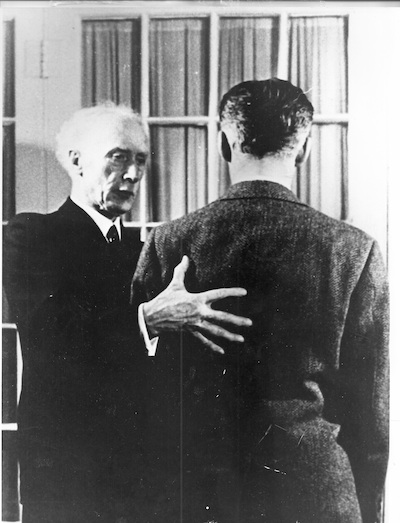 |
| Photo © 2010 The Society of Teachers of the Alexander Technique, London | F. M. Alexander teaching (1940s). |
An Alexander Technique student learns to change tension habits that have been built up over a course of a lifetime. Private in-person lessons focus on the individual student learning and applying the Principles of the Technique in ways that are most effective and beneficial for him/her. The number of lessons a student may want to take may be based on several factors, including his or her individual conditions, rate of progress, and the particular improvements he or she may be seeking.
F. M. Alexander, the creator of the Alexander Technique, generally recommended that students take thirty private lessons. While most students experience significant improvements with a smaller number of lessons, a series of thirty lessons provides students with the new experiences that provide the best opportunity to make very substantial and lasting positive changes in deep-rooted, lifetime tension habits. A series also provides students with the instruction and time needed to learn the Principles of the Technique well enough to continue to progress on their own after they stop taking lessons.
A prospective student usually takes an introductory lesson(s), and then decides if he/she would like to continue taking lessons. It's recommended that new students take lessons at least one or more times a week. Generally, it's better to have lessons one or more times a week than to have lessons less frequently over a longer period of time.
For people who are unable to take lessons on a regular basis, a series of lessons can be taken in smaller sets. For example, a person may take a set of three to five lessons and then have another set of three to five lessons several weeks or months later. Between sets of lessons, the student can use what he/she has learned to help maintain improvement and awareness.
Can the Alexander Technique be learned online?
No. The gentle hands-on guidance provided by the teacher to the student is the key part of an Alexander Technique lesson. This guidance gives the new and unfamiliar experiences and sensations that provide for more natural coordination and less undue tension. These new and non-habitual experiences are a reeducation for the student's neuromuscular system. Otherwise, the student depends entirely on his or her own neuromuscular system, which is conditioned and guided by undue tension habits, to try to change those same tension habits. This creates a vicious circle that, as Alexander emphasized in his writings, impedes genuine improvement, can make existing problems worse, and may even create new habits of misuse. Alexander based his Technique on this fundamental understanding.
Early in his career, F. M. Alexander tried to teach using only verbal instruction. He quickly found that didn't work well. Alexander added hands-on guidance to give his students the direct experience of more natural and improved use, which worked much better. He continued to develop and refine this hands-on instruction for many years.
All scientific studies on the effectiveness of the Alexander Technique have been conducted using in-person learning with hands-on guidance. Link
While there can be virtual learning that doesn't involve the tangible experiences provided by hands-on guidance, that type of learning is not the same in-depth reeducation that the Alexander Technique teaches. More Information.
Is the Alexander Technique a kind of treatment or therapy—similar to massage therapy, physical therapy, bodywork, or other therapies?
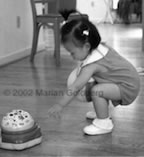 |
| A small child squats with an easy and natural coordination. |
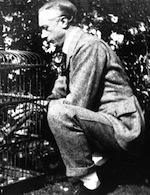 Photo © 2014 The Society of Teachers of the Alexander Technique, London |
| F. M. Alexander with the same easy and natural coordination as the chlld pictured above. |
The Alexander Technique is known for its significant therapeutic benefits. However, the Technique is an educational method rather than a therapy or treatment. The Alexander Technique is based on an unusual, if not unique, paradigm that is very unlike medical, treatment, and exercise models. The Technique’s premises and principles include: (1) the mind and body function as a completely integrated whole; (2) our innate coordination works efficiently and easily; (3) our natural coordination and our ability to accurately sense and self-correct our posture, muscular use, and movement become compromised by mind-body tension habits; (4) When we reduce the interference —our poor habits—that we have imposed on our innate coordination, our coordination is able to work efficiently and comfortably and our ability to accurately sense and self-correct what we are doing is restored and (5) Rather than seeing the body from a strictly anatomical perspective —as a set of separate parts—the Technique always considers the body as an integral whole. The Technique is concerned with the basic principles that determine the general coordination of the body as a whole and with stopping the habits that interfere with this natural coordination.This allows the various "parts" that are subject to undue stress and strain to achieve a more balanced and better integrated functioning with the rest of the system.
Treatment and therapy models are generally concerned with doing something to or with conditions that are themselves often the result of or exacerbated by poor habits. The Alexander Technique does not involve “doing more" or "adding more” —such as exercises or manual treatment techniques—on top of what we are already doing with our maladaptive habits. Rather, the Technique is about learning to do less, that is, stopping the habits themselves. This comprehensive and key process of “non-doing” of ingrained habit patterns allows our natural and more efficient coordination to work and our systems to heal without habitual interference.
So, rather than seeing the body as a set of “parts” or pressure points to be individually treated or "worked on,” a skilled Alexander teacher gently guides a student through natural patterns of movement, observing and working with the coordination of the person as a whole, which includes tension and postural patterns, how a student thinks about moving, and active movement itself. The student actively participates in this fascinating and rewarding re-educational process, learning to apply his/her own intelligence to effectively stop and change entrenched habits and restore natural and efficient functioning. The Alexander Technique is a comprehensive re-education in functioning at a fundamental level.
Are the lessons about learning exercises? Is the Alexander Technique similar to Yoga, Pilates, T'ai Chi, or dance training?
The Alexander Technique is not about learning specific exercises or movements but it can be very helpful in improving the performance of various exercise and movement methods. The Technique provides the student with the means to change habitual, stressful and malcoordinated responses to stimuli. Practicing the Alexander Technique promotes healthier and more natural patterns of movement. The resulting improved coordination provides a healthier foundation for practicing various exercise methods and fitness programs.
What are the lesson rates?
Since the Alexander Technique is an educational method and students often take a number of lessons, lesson fees are typically similar to private lessons in other kinds of techniques and disciplines. Private lesson rates can range from $55 to $140 and can depend on several factors, including: the skill, experience, and Alexander Technique training of the teacher, the length of the lesson (lessons generally range from half-an-hour to an hour) and the geographical location. Some Alexander Technique students use Flexible Spending Accounts (FSAs) to pay for lessons.
Can I learn the Alexander Technique by taking group classes instead of private lessons?
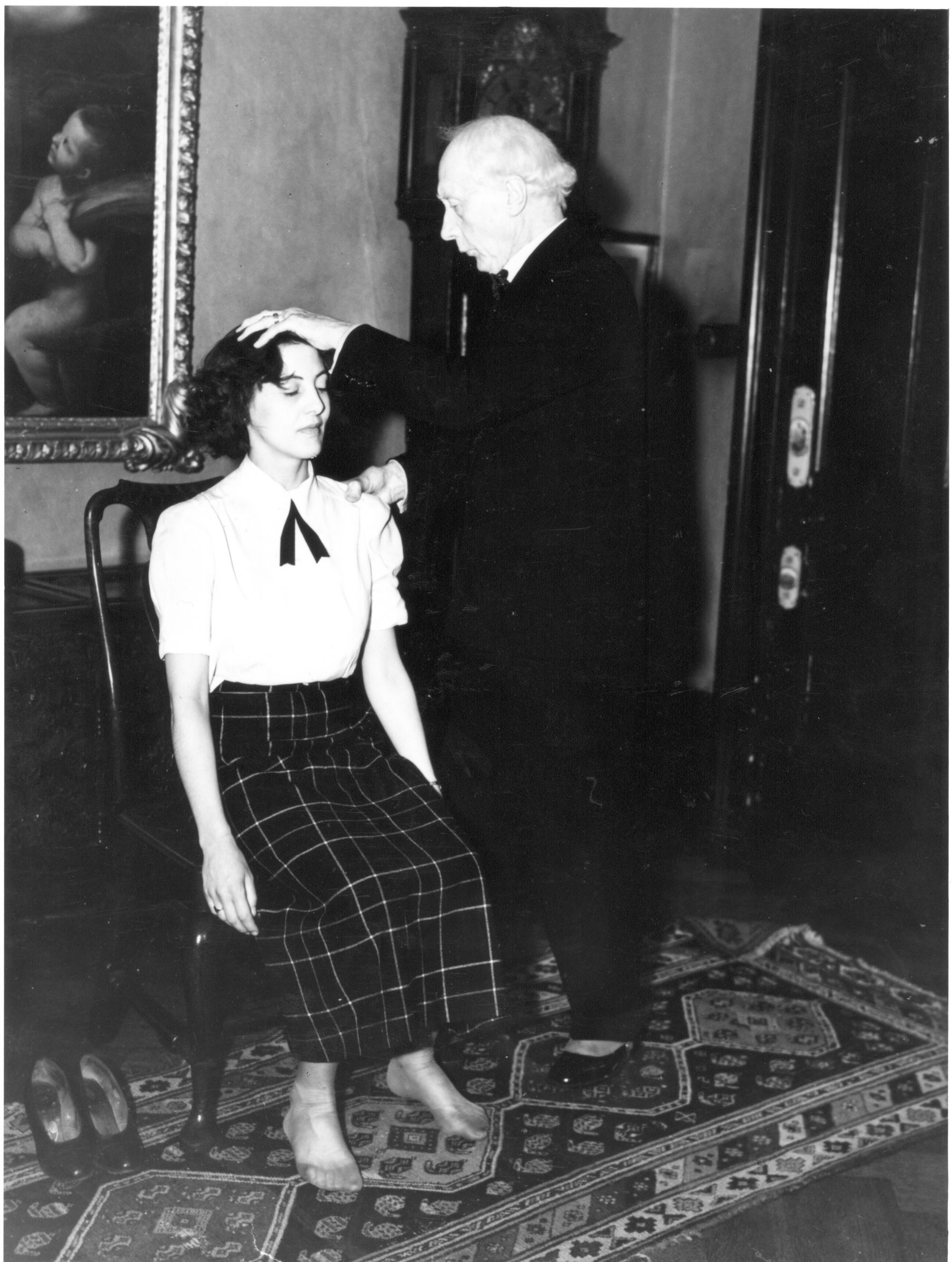 |
| Photo © 2010 The Society of Teachers of the Alexander Technique, London | F. M. Alexander teaching a lesson. (1940s). |
Classes and workshops can serve as an introduction to the Technique and can offer some helpful hints. However, since classes attempt to teach the Alexander Technique in a group setting, there are some basic problems with them: they lack sufficient experience in the hands-on guidance that provides for making substantive changes in ingrained habits and at best they offer a cursory presentation of the Technique.
Although F. M. Alexander did briefly try at one point early in his teaching career to teach the Technique to a group class, he apparently did not find this effective, particularly in comparison to private lessons that focus on each individual's unique habits and use. Despite that Alexander greatly enjoyed and had considerable success with speaking and performing to groups as an actor and reciter, he chose to teach his Technique on an individual basis through private lessons throughout the almost 60 years he taught his Technique. The only exceptions to this were small classes with people who already had a considerable number of private lessons: his teacher-training course and, for a few years, a small class for children. In his teaching, speaking, and writing, F. M. Alexander always emphasized the importance of the individual.
Alexander also wrote in his books about the problems people have with the dynamics of what today could be called “group think” or "group mentality." The pressures on the individual to conform or perform—"live up to expectations"—that tend to occur in a group setting often create additional stress and undue tension. Adding unnecessary stress and tension while trying to learn to stop tension habits is clearly counterproductive. This is very likely another reason Alexander emphasized learning the Technique on an individual basis through private lessons.
Does it help to combine the Alexander Technique with other methods or therapies?
Whatever you are doing can be improved by the Alexander Technique but not necessarily vice versa because the Technique is primary. The Alexander Technique's unique learning process works with improving coordination and functioning at their most basic levels. This improved coordination and functioning can then provide a healthier foundation for the practice of various exercise, therapeutic, and fitness methods.
The Alexander Technique Center
The Teacher
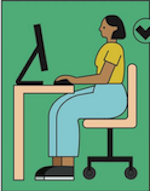 |
Marian Goldberg maintains a private Alexander Technique teaching practice in the Washington, D.C. area and is the Director of the Alexander Technique Center of Washington's Teacher-Training Program. Marian began studying the Alexander Technique in 1978. After working with a variety of interpretations of the Alexander Technique from 1978 to 1980, she went on to study with Joan and Alexander Murray at the Urbana Center for the Alexander Technique in 1980. Marian graduated from the Urbana Centerís intensive teacher-training program in 1983, fulfilling the three-year daily training standards established by F. Matthias Alexander, the creator of the Alexander Technique. In addition, Marian completed two years of advanced training at the Urbana Center. She has been teaching the Technique since 1983 and is certified by both the Society of Teachers of the Alexander Technique (STAT), UK, and the American Society for the Alexander Technique (AmSAT). Marian also studied with teachers trained directly by F. M. Alexander: Walter Carrington, Peggy Williams, and Marjorie Barstow. She has taught classes and workshops in the Technique for colleges and universities and for a number of organizations, including the United States Marine Band, the Vocal Studies Program at George Mason University, the National Orchestral Institute, and the University of Illinois. Her articles have appeared in several publications, including The Alternative Health Sourcebook and Natural Awakenings magazine. Marian has developed several web sites: “Alexander Technique: The Insiders’ Guide,” “John Dewey and the Alexander Technique” and “The Alexander Technique for Musicians.” She is the editor of Beginning from the Beginning: A Conversation with Joan and Alexander Murray. Marian has also been certified as a Feldenkrais® Practitioner and has trained in Cranio-Sacral Therapy.
Scheduling Lessons and More Information
To schedule a lesson at the Alexander Technique Center, and/or for more information, e-mail info@alexandercenter.com or phone (703) 821-2920. If you would like to have information sent to you by postal mail, please provide your name and address.
Location
The Alexander Technique Center is located in McLean (Fairfax County), Virginia, within ten minutes drive of Tysons Corner, the City of Falls Church, and Arlington in Northern Virginia, Chain Bridge (Washington, DC), and the Maryland suburbs (American Legion Bridge/495); 15 to 20 minutes from Key Bridge (Washington, D.C.), Potomac, Maryland, and Great Falls, Reston, Vienna, Oakton, and Annandale in Northern Virginia; and 20 to 30 minutes from Bethesda, Chevy Chase, and Rockville in Maryland, and from Springfield, Herndon, Burke, and the cities of Fairfax and Alexandria in Virginia.
Return to:
Top of Page
Alexander Technique Center of Washington
Alexander Technique: The Insiders’ Guide
© 2004, 2007, 2013, 2017, 2023, 2024 Marian Goldberg
Alexander Technique: The Insiders’ Guide
Web site maintained
by Marian Gol

